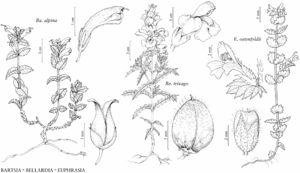Difference between revisions of "Bellardia trixago"
Fl. Pedem. 1: 61. 1785.
FNA>Volume Importer |
imported>Volume Importer |
||
| (3 intermediate revisions by 2 users not shown) | |||
| Line 13: | Line 13: | ||
}}{{Treatment/ID/Special_status | }}{{Treatment/ID/Special_status | ||
|code=F | |code=F | ||
| − | |label= | + | |label=Illustrated |
}} | }} | ||
|basionyms={{Treatment/ID/Basionym | |basionyms={{Treatment/ID/Basionym | ||
|name=Bartsia trixago | |name=Bartsia trixago | ||
|authority=Linnaeus | |authority=Linnaeus | ||
| + | |rank=species | ||
|publication_title=Sp. Pl. | |publication_title=Sp. Pl. | ||
|publication_place=2: 602. 1753 | |publication_place=2: 602. 1753 | ||
| Line 36: | Line 37: | ||
|elevation=0–900 m. | |elevation=0–900 m. | ||
|distribution=Calif.;La.;Tex.;Europe;n Africa;introduced also in s South America;w Asia;s Africa;Atlantic Islands (Canary Islands);s Australia. | |distribution=Calif.;La.;Tex.;Europe;n Africa;introduced also in s South America;w Asia;s Africa;Atlantic Islands (Canary Islands);s Australia. | ||
| + | |introduced=true | ||
|discussion=<p>Although known in California since at least 1889 (Greene s.n., 1889, UC), <i>Bellardia trixago</i> has appeared in the southeastern United States much more recently. First collected in Texas in 1970, <i>B. trixago</i> was documented in Louisiana in 2007, its easternmost locality in the flora area, and it seems to be moving eastward and southeastward more quickly than northward (J. R. Singhurst et al. 2012). <i>Bellardia trixago</i> rarely forms dense populations in the flora area.</p> | |discussion=<p>Although known in California since at least 1889 (Greene s.n., 1889, UC), <i>Bellardia trixago</i> has appeared in the southeastern United States much more recently. First collected in Texas in 1970, <i>B. trixago</i> was documented in Louisiana in 2007, its easternmost locality in the flora area, and it seems to be moving eastward and southeastward more quickly than northward (J. R. Singhurst et al. 2012). <i>Bellardia trixago</i> rarely forms dense populations in the flora area.</p> | ||
|tables= | |tables= | ||
| Line 45: | Line 47: | ||
-->{{#Taxon: | -->{{#Taxon: | ||
name=Bellardia trixago | name=Bellardia trixago | ||
| − | |||
|authority=(Linnaeus) Allioni | |authority=(Linnaeus) Allioni | ||
|rank=species | |rank=species | ||
| Line 60: | Line 61: | ||
|publication title=Fl. Pedem. | |publication title=Fl. Pedem. | ||
|publication year=1785 | |publication year=1785 | ||
| − | |special status=Introduced; | + | |special status=Introduced;Illustrated |
| − | |source xml=https:// | + | |source xml=https://bitbucket.org/aafc-mbb/fna-data-curation/src/2e0870ddd59836b60bcf96646a41e87ea5a5943a/coarse_grained_fna_xml/V17/V17_837.xml |
|genus=Bellardia | |genus=Bellardia | ||
|species=Bellardia trixago | |species=Bellardia trixago | ||
Latest revision as of 20:37, 5 November 2020
Stems simple or with few ascending branches, (5–)10–70 cm, retrorsely short-strigose. Leaves 12–22 pairs, ascending or divaricate, antrorsely short-strigose, glandular-hairy; blade oblong-lanceolate or linear, (10–)14–90[–95] x 2–20 mm, margins green, apex acute. Spikelike racemes 1–14 cm; flowers 2–16(–25) pairs, dense, not interrupted proximally, glandular-hairy; peduncle absent; bracts foliaceous, 8–23 x 3–11 mm, margins of proximal bracts +/- coarsely dentate, margins of distal bracts +/- entire. Pedicels 1–2 mm, hairy. Flowers: calyx tubular, 7–9 mm, tube 4–6 mm, hairy or glandular-hairy, lobes unequal, triangular, 0.5–7 x 2–4 mm, herbaceous, margins entire, apex acute, glandular-hairy; corolla white with purple galea, 18–25(–30) mm, sparsely glandular-hairy externally, throat with 2 inflated lines between lateral and central lobes, abaxial lobes spreading, adaxial projecting; stamens included, pollen sacs yellow, 2–2.5 mm, mucronate distally, brownish villous proximally, scarcely hairy distally, dehiscing longitudinally in distal 3/4–4/5; style 14–20 mm, puberulent; stigma clavate, capitate, or +/- 2-lobed. Capsules 7–10 x 4.5–8 mm, setose or villous, some hairs glandular. Seeds 0.5–1 mm, longitudinally ridged or smooth. 2n = 24 (Spain).
Phenology: Flowering Mar–Jun.
Habitat: Disturbed grasslands, roadsides, fields, serpentine grasslands.
Elevation: 0–900 m.
Distribution
Introduced; Calif., La., Tex., Europe, n Africa, introduced also in s South America, w Asia, s Africa, Atlantic Islands (Canary Islands), s Australia.
Discussion
Although known in California since at least 1889 (Greene s.n., 1889, UC), Bellardia trixago has appeared in the southeastern United States much more recently. First collected in Texas in 1970, B. trixago was documented in Louisiana in 2007, its easternmost locality in the flora area, and it seems to be moving eastward and southeastward more quickly than northward (J. R. Singhurst et al. 2012). Bellardia trixago rarely forms dense populations in the flora area.
Selected References
None.
